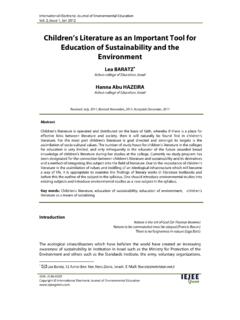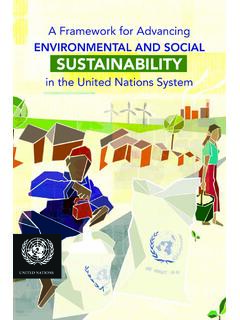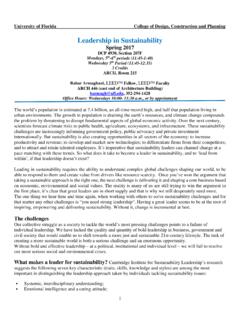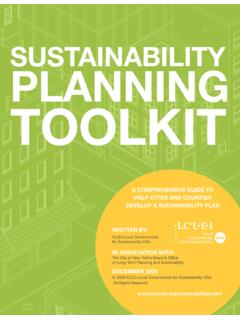Transcription of ENVIRONMENTAL HEALTH: WORLD HEALTH …
1 1/2/20131 INTRODUCTION TO GLOBAL ENVIRONMENTAL CONCERNS1 ENVIRONMENTAL HEALTH : WORLD HEALTH ORGANIZATION (WHO) DEFINITION ENVIRONMENTAL HEALTH comprises those aspects of human HEALTH , including quality of life, that are determined by physical, biological, social, and psychosocial factors in the environment. It also refers to the theory and practice of assessing, correcting, controlling, and preventing those factors in the environment that can potentially affect adversely the HEALTH of present and future generations Of the 102 major diseases reported yearly in the WORLD HEALTH Report, 85 are partly caused by exposures to ENVIRONMENTAL risk factorsBEGINNINGS OF ENVIRONMENTAL AWARENESS1/2/201323 HISTORICAL PERSPECTIVEFour distinct stages of the ENVIRONMENTAL movement Pragmatic Resource Conservation Moral and Aesthetic Nature Preservation Concern about HEALTH and Ecological Damage Global ENVIRONMENTAL Citizenship*These stages are not mutually exclusive *4 PRAGMATIC RESOURCE CONSERVATION Phrase first coined by Gifford Pinchot, conservation advisor to Theodore Roosevelt Influenced by John Marsh s book.
2 Man and Nature His policy was labeled as Pragmatic Utilitarian Conservation For the greatest good for the greatest number for the longest time 5 ETHICAL AND AESTHETIC NATURE PRESERVATION Nature deserves to exist for its own sake - regardless of degree of usefulness to humans Promoted by individuals such as John Muir (Sierra Club founder) and Aldo Leopold , author of The Land Ethic Premises: Land is not a commodity belonging to us that may be abused Man is not more valuable than all of creationThese ideas have given way to that of ENVIRONMENTAL sustainability 1/2/201336 ENVIRONMENTAL SUSTAINABILITY Current trend in understanding ENVIRONMENTAL conservation Combines former elements but adds emphasis on : Human HEALTH Global citizenship ENVIRONMENTAL justice Often encompassed in broader concept of sustainable development 7 SUSTAINABLE DEVELOPMENT Movement started with Brundtland Commission Report of 1987 entitled Our Common Future Meeting the needs of the present without compromising the ability of future generations to meet their own needs.
3 Benefits must be available to all humans, rather than to a privileged few Encompasses ENVIRONMENTAL preservation as well as human health8 SUSTAINABLE DEVELOPMENT Brundtland Commission report led to the first Earth Summit in 1992 Rio Declaration and Agenda 21 resulted These two documents provided key international commitments to conservation and management of natural resources, social, economic, and HEALTH issues across multiple levels Agenda 21 is still considered to be the most important non-binding instrument in ENVIRONMENTAL field today 2002- WORLD Summit on Sustainable Development-included priority areas of energy, HEALTH , water and sanitation, agriculture and biodiversity1/2/201349 WHO STANCEKey messages from Putting HEALTH at the Front of the Global Green Agenda at the Rio 2012 conference: HEALTH is an important input to sustainable development healthy people are better able to learn, work and contribute to their economies and societies.
4 Universal access to HEALTH services is key input to better HEALTH . Sustainable Development can improve HEALTH smart strategies for transport, housing, energy & agriculture reduce NCDs and diseases of poverty, and enhance HEALTH ( physical activity). This is not automatic! " HEALTH in green economy" opportunities have not been fully exploited. HEALTH risks and benefits of different economic development strategies need more explicit consideration HEALTH indicators can measure the success of sustainable development goals and support governance. ENVIRONMENTAL issues also overlap many of the Millennium Development Goals10 ENVIRONMENT S EFFECT ON HUMAN WELL-BEING Ecosystem services mediate the interaction between human well-being and the natural environment Provisioning services: food and water Change reduces access to basic needs Regulating services: flood and disease control Change reduces security and HEALTH Cultural services: spiritual, cultural, and recreational benefits Change reduces social and cultural relations Supporting services: nutrient cycling that maintains conditions for life on earthTHE RECIPROCITY OF HUMAN HEALTH AND THE ENVIRONMENT1/2/2013512 Human effects on the environment and ENVIRONMENTAL effects on human HEALTH are an interconnected and complex web of interactions13 RECIPROCAL EFFECTS.
5 HEALTH ENVIRONMENT Climate Change Burning fossil fuels has changed the global climate This has multiple effects on ocean life, air quality , and food supply, all of which affect human HEALTH Also associated with increase in natural disasters14 RECIPROCAL EFFECTS: HEALTH ENVIRONMENT Food 2/3 of agricultural lands show signs of degradation Food scarcity exists in large pockets of the WORLD , often due to changing climates Water Human consumption and pollution of water drives scarcity 1/3 of the WORLD lives in water stressed areas, increasing adverse HEALTH outcomes1/2/2013615 RECIPROCAL EFFECTS: HEALTH ENVIRONMENTC hemical pollution of the food chain PCPs and heavy metals are beingfound in high levels in the diets of Inuit people in Artic regions Contaminants come from both oceancurrents and the wind16 RECIPROCAL EFFECTS: HEALTH ENVIRONMENT Energy: Fossil fuel use pollutes Other energy supplies are being depleted Air Pollution Population growth, use of fossil fuels, and chemicals pollute the air Poor air quality increases morbidity of populations Biodiversity Species are being lost at a rapid rate worldwide Unknown effects years may occur later in the disruption of biosystems, human food supply through the food chain, etc17A DIVIDED WORLD : GLOBAL DISPARITIES IN HEALTH AND THE ENVIRONMENT Approximately 20% of the WORLD s population lives in countries with per capita income > $35,000 per year Remaining 80% lives in middle or low income countries More than billion people live in extreme poverty: < $ ( ) per day ( WORLD Bank) The poor must meet present survival needs, often at the cost of long term sustainability1/2/2013718A DIVIDED WORLD Increasing gap between rich and poor affects many quality of life indicators.
6 When compared to inhabitants of developed countries, the poor have: Less access to sanitation facilities Less access to clean water Higher percentage of pollutants in air Higher morbidity from water borne illness Higher morbidity from air pollution Higher injury rate from jobs such as garbage picking19 AIR POLLUTION A clear dichotomy in air pollution trends exists Developed nations: levels of many pollutants have declined markedly due to good governance Developing countries: levels of air pollution continue to rise Growing fossil fuel consumption Intensification of manufacturing activities Indoor air pollution: biomass fuels used for cooking linked to COPD, asthma, lung cancer and other issues20 SANITATION AND WATER quality Access to safe drinking water: Developed countries: more than 90% High income developing countries: 75 to 90 % Developing countries: close to 50% of the population Approximately 900 million people in developing countries live without continuous access to safe drinking water Only 62% of WORLD s population has access to improved sanitation facilities1/2/2013821 INJURIES ENVIRONMENTAL factors that drive injuries: Poorly designed cook-stoves Poorly designed roadways Substandard housing at risk of collapse Accidental poisonings by pesticides Festering domestic and interpersonal violence A transition in injury risk occurs with change in level of development: Early development: injuries from fires, agricultural injuries, drownings, wood-acquisition injuries, and war-related violence dominate Continued economic development: road traffic, intentional, and industrial injuries increaseKEY DRIVERS AND ISSUES IN CURRENT GLOBAL ENVIRONMENTAL HEALTH23 GLOBAL DRIVERS OF ENVIRONMENTAL HEALTH Can be broadly grouped into 3 categories.
7 Economic growth Although unequally distributed, worldwide trend is toward rapid economic growth This promotes unsustainable consumption patterns Example: dramatic global increase in vehicle use over last 2 decades Pollution Wastes These factors often contribute to HEALTH disparitiesFactors that motivate, stimulate, or push the ENVIRONMENTAL processes that affect human health1/2/2013924 GLOBAL DRIVERS OF ENVIRONMENTAL HEALTH More specific drivers include: Population growth Technological and economic development Increased need for energy use Increased technology- primarily in food production Potential positive effects with genetic engineering Potential degradation of ecosystem services Changing lifestyles and social attitudes Natural processes of change in the physical environment Policy interventions Long-term impacts of past human interventions Vulnerability and coping capacity Globalization Agriculture and food security Urbanization25 HUMAN VULNERABILITYA function of exposure, sensitivity, and adaptive capacityOccurs on a continuum from highly vulnerable to highly secureVulnerability consists of 2 primary elements.
8 Exposure to ENVIRONMENTAL hazards (stressors, shocks, and contingencies) Coping capacityEnvironmental refugees Many highly vulnerable populations are being forced to eco-migrate as a result of ENVIRONMENTAL change Estimated 25 million people in mid-1990s, up to 200 million at risk26 POPULATION GROWTHThe earth must sustain 3 x more people todaythan it did at the beginning of the 20thcentury1/2/20131027 GLOBALIZATIONThe process of interlocking economic, social, technological, political, and cultural changes emerging around the WORLD Positive: provides cooperation, problem solving opportunities, and higher productivity Negative: Provides disease agents opportunities to move into new niches through global trading Provides growing points of contact for humans with wildlife Promotes increased agricultural practices that encroach into forested areas28 FOOD PATTERNS Local food patterns controlled by ENVIRONMENTAL factors: water availability physical and chemical properties of soils prevailing climatic conditions WORLD nutrition patterns.
9 Undernutritionremains a significant cause of morbidity and mortality in developing WORLD Overnutritionin developed WORLD (add increasingly amogst wealthier worldwide) is a result of diets with higher fat content, more refined carbohydrates, less fiber, and more salt, as well as less physically active lifetyles Leads to hypertension, cardiac disease, diabetes and other HEALTH problems29 URBANIZATION Number of people in cities now exceeds that in rural communities Rapid urbanization is common among cities in developing world1/2/20131130 PROBLEMS WITH URBANIZATION Population growth may outstrip resources Result of natural increases (childbirth) as well as migration Migration often driven by farmers being put out of work due to globalized, technology led food production practices Increased populations in coastal cities is causing ocean pollution and degradation Rapid expansion of illegal or unplanned and un-serviced settlements (slums) UN-HABITAT estimated in 2005 that there were over 1 billion slum dwellers worldwide31 HEALTH ISSUES IN URBAN SLUMS Slums provide unhealthy living conditions and extreme overcrowding Residents often lack access to basic amenities including sanitation, piped water, waste disposal, and electricity Residents exposed to many stressors such as chemical and biological agents, natural disasters, noise pollution, and extreme heat32 HEALTH ISSUES IN URBAN SLUMS Ambient Air Pollution: Industrial and transportation related sources Combustion by-products from domestic cooking and heating Indoor Air Pollution: Access to electricity is unreliable Dependence on dirty-burning fuels for cooking inside homes Water: Water demand may outstrip the supply Chemical and biological pollutants Infectious Diseases: High population density and crowding promote transmission of infectious diseases1/2/20131233 HEALTH ISSUES IN URBAN SLUMS Waste Disposal.
10 Illegal dumping and burning of solid wastes and sewage Close vicinity to waste dumps Poor sanitation contaminates food and water supply Change in behaviors: Lower quality diets Increased participation in sexual activity Insufficient access to adequate healthcare Few legal rights34 REGIONAL CONCERNSA frica: Land degradation threatens agriculture: area of over 500 million sq km lost Per capita food production declined by 12 percent since 1981 Affects river catchments, forests, and the expansion of deserts Regional efforts include integrated crop and land management programsAsia and the Pacific: Rapid population growth, higher incomes, burgeoning urban development times the number of automobiles in use compared to 20 years ago Poor urban air quality Significant water stress on freshwater and degraded ecosystems Increased electronic and hazardous waste35 REGIONAL CONCERNSN orth America: Excessive energy use Urban sprawl Improvements made in water conservationWest Asia: Freshwater stresses- one of the most stressed regions of the WORLD Land degradation Rapid increase in air pollution as vehicle use climbs Coastal and marine ecosystems degradation by war related oil spillsThe Polar Regions : Climate change (warming twice as fast as rest of WORLD ) Persistent pollutants are contaminating food supply Depletion of the ozone layer1/2/20131336 REGIONAL CONCERNSE urope: Rising incomes and increasing per capita household consumption Increased energy use and emissions of greenhouse gases Poor urban air quality and transportation challenges remain Positive legislative action is improving many issuesLatin America and the Caribbean.
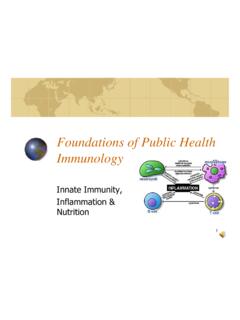

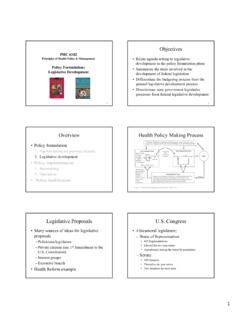




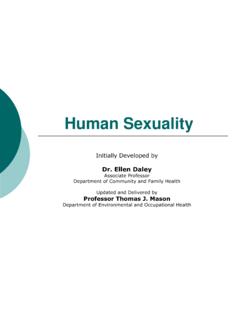

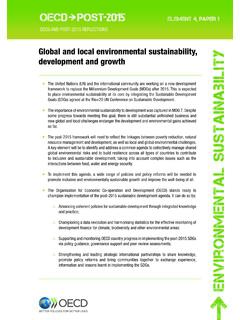
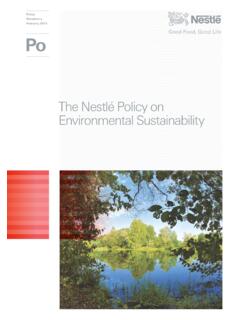
![[Draft] European Sustainability Reporting Standard G2 ...](/cache/preview/1/b/d/8/0/0/0/b/thumb-1bd8000bf981ed16b3b23735278f0aeb.jpg)
